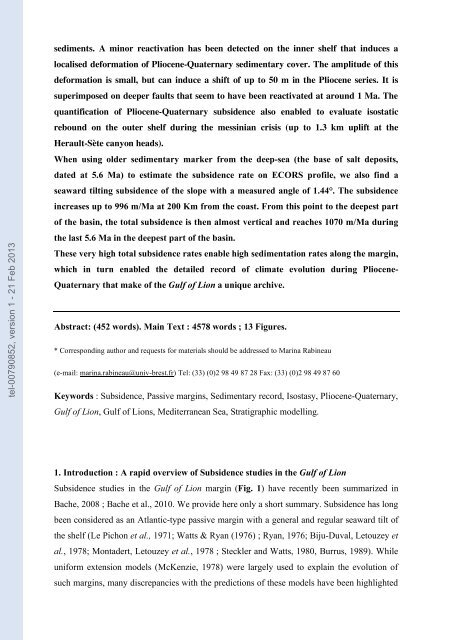Quantification des flux sédimentaires et de la subsidence du bassin ...
Quantification des flux sédimentaires et de la subsidence du bassin ...
Quantification des flux sédimentaires et de la subsidence du bassin ...
You also want an ePaper? Increase the reach of your titles
YUMPU automatically turns print PDFs into web optimized ePapers that Google loves.
tel-00790852, version 1 - 21 Feb 2013<br />
sediments. A minor reactivation has been d<strong>et</strong>ected on the inner shelf that in<strong>du</strong>ces a<br />
localised <strong>de</strong>formation of Pliocene-Quaternary sedimentary cover. The amplitu<strong>de</strong> of this<br />
<strong>de</strong>formation is small, but can in<strong>du</strong>ce a shift of up to 50 m in the Pliocene series. It is<br />
superimposed on <strong>de</strong>eper faults that seem to have been reactivated at around 1 Ma. The<br />
quantification of Pliocene-Quaternary subsi<strong>de</strong>nce also enabled to evaluate isostatic<br />
rebound on the outer shelf <strong>du</strong>ring the messinian crisis (up to 1.3 km uplift at the<br />
Herault-Sète canyon heads).<br />
When using ol<strong>de</strong>r sedimentary marker from the <strong>de</strong>ep-sea (the base of salt <strong>de</strong>posits,<br />
dated at 5.6 Ma) to estimate the subsi<strong>de</strong>nce rate on ECORS profile, we also find a<br />
seaward tilting subsi<strong>de</strong>nce of the slope with a measured angle of 1.44°. The subsi<strong>de</strong>nce<br />
increases up to 996 m/Ma at 200 Km from the coast. From this point to the <strong>de</strong>epest part<br />
of the basin, the total subsi<strong>de</strong>nce is then almost vertical and reaches 1070 m/Ma <strong>du</strong>ring<br />
the <strong>la</strong>st 5.6 Ma in the <strong>de</strong>epest part of the basin.<br />
These very high total subsi<strong>de</strong>nce rates enable high sedimentation rates along the margin,<br />
which in turn enabled the d<strong>et</strong>ailed record of climate evolution <strong>du</strong>ring Pliocene-<br />
Quaternary that make of the Gulf of Lion a unique archive.<br />
Abstract: (452 words). Main Text : 4578 words ; 13 Figures.<br />
* Corresponding author and requests for materials should be addressed to Marina Rabineau<br />
(e-mail: marina.rabineau@univ-brest.fr) Tel: (33) (0)2 98 49 87 28 Fax: (33) (0)2 98 49 87 60<br />
Keywords : Subsi<strong>de</strong>nce, Passive margins, Sedimentary record, Isostasy, Pliocene-Quaternary,<br />
Gulf of Lion, Gulf of Lions, Mediterranean Sea, Stratigraphic mo<strong>de</strong>lling.<br />
1. Intro<strong>du</strong>ction : A rapid overview of Subsi<strong>de</strong>nce studies in the Gulf of Lion<br />
Subsi<strong>de</strong>nce studies in the Gulf of Lion margin (Fig. 1) have recently been summarized in<br />
Bache, 2008 ; Bache <strong>et</strong> al., 2010. We provi<strong>de</strong> here only a short summary. Subsi<strong>de</strong>nce has long<br />
been consi<strong>de</strong>red as an At<strong>la</strong>ntic-type passive margin with a general and regu<strong>la</strong>r seaward tilt of<br />
the shelf (Le Pichon <strong>et</strong> al., 1971; Watts & Ryan (1976) ; Ryan, 1976; Biju-Duval, L<strong>et</strong>ouzey <strong>et</strong><br />
al., 1978; Monta<strong>de</strong>rt, L<strong>et</strong>ouzey <strong>et</strong> al., 1978 ; Steckler and Watts, 1980, Burrus, 1989). While<br />
uniform extension mo<strong>de</strong>ls (McKenzie, 1978) were <strong>la</strong>rgely used to exp<strong>la</strong>in the evolution of<br />
such margins, many discrepancies with the predictions of these mo<strong>de</strong>ls have been highlighted

















